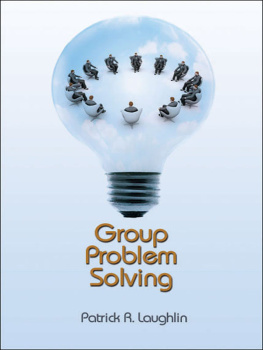On the Beat
On the Beat
Police and Community Problem Solving
Wesley G. Skogan
Susan M. Hartnett
Jill DuBois
Jennifer T. Comey
Marianne Kaiser
Justine H. Lovig
First published 1999 by Westview Press
Published 2019 by Routledge
52 Vanderbilt Avenue, New York, NY 10017
2 Park Square, Milton Park, Abingdon, Oxon OX14 4RN
Routledge is an imprint of the Taylor & Francis Group, an informa business
Copyright 1999 by Taylor & Francis
All rights reserved. No part of this book may be reprinted or reproduced or utilised in any form or by any electronic, mechanical, or other means, now known or hereafter invented, including photocopying and recording, or in any information storage or retrieval system, without permission in writing from the publishers.
Notice:
Product or corporate names may be trademarks or registered trademarks, and are used only for identification and explanation without intent to infringe.
A CIP catalog record for this book is available from the Library of Congress
ISBN 13: 978-0-367-28183-0 (hbk)
To Arnold Mireles
We would like to thank Chicago Police Superintendents Terry Hillard and Matt Rodriguez for their cooperation and encouragement of this evaluation. Similar support came from former Deputy Superintendent Charles Ramsey, Chief of Patrol Tony Chiesa, and Research and Development Director Barbara McDonald and former Deputy Director Nola Joyce. We are also grateful for the continued interest in this evaluation evidenced by Chicago's public officials, including Mayor Richard M. Daley, the heads of many city agencies, and CAPS Implementation Director Theodore O'Keefe. Their receptivity allowed us exceptional access to the police department, city hall and the other municipal agencies that were involved in the program. The staff of the Chicago Alliance for Neighborhood Safety willingly provided information and assistance, beginning with its director, Warren Friedman.
Encouragement and financial assistance for this research was extended by the board members and staff of the Illinois Criminal Justice Information Authority, including Peter Bensinger, Candice Kane, Roger Przybylski and David Olson. Federal support for the project came from the National Institute of Justice, ably represented by Jeremy Travis, Sally Hillsman and Lois Mock. On several occasions timely financial assistance has been forthcoming from the John D, and Catherine T. Mac Arthur Foundation, which is notable for its commitment to Chicago and to systematic evaluation. Work on the manuscript was facilitated by the hospitality of Ugljesa Zvekic, Gloria Laycock and Nick Tilley. The time to complete it was generously supported by a Senior Fellowship from the Center for Crime, Communities and Culture of the Open Society Institute. Valuable assistance and encouragement was provided at many junctures by the staff of Northwestern University's Institute for Policy Research, and its director, Fay Lomax Cook.
Key members of our research team who are not represented in the list of authors included Aaron Bicknese, Archon Fung, Robert Jessen, Jinney Smith, Karla Twedt-Ball, Wuvi Wang and Alexander Young. Professor Richard Block of Loyola University and Sergeantjonathan Lewin of the Chicago Police Department provided valuable crime mapping and analysis assistance. Jill DuBois, editorial director of our projects and one of the authors of this book, coordinated the production of this manuscript.
Introduction
For several months neighbors had been flocking to their local police-community meeting to complain about unsavory goings-on at a nearby residential hotel. Although what was actually going on inside the facility was a subject of speculation and rumor, neighborhood residents could observe prostitutes soliciting passers-by on the street and leading customers to the hotel. As drug dealers plied their trade just outside, gang members were entering and leaving the premises around the clock. The scene was so objectionable that the principal of the Catholic school across the street had to move a classroom of students to the back part of the building so they would not be exposed to the commotion.
Officers assigned to the area decided to run a computer check of arrests made at and around the hotel, and they contacted the city's emergency dispatch facility to obtain numbers on calls for service to that address. Not too surprisingly, there had been a lot of both. Armed with the data, the officers came to the subsequent meeting prepared to brainstorm with community members about appropriate strategies for attacking this problem. By the end of the meeting, the combined forces of the beatpolice officers and neighborhood residentswere mobilized to launch a multi-pronged attack on the hotel.
With help from the districts neighborhood relations officers, community members tracked down the name of the hotel owner and arranged for a hearing at the city's licensing commissioner's office. They took pictures to document the complaints they would be airing there. To augment their increased patrolling activities, beat officers contacted the city's Department of Buildings to request inspections of the premises, and they filled out city service request forms to have municipal crews replace burned out streetlights and repair the curbs and sidewalks.
The numerous violations uncovered at the inspectionsranging from code violations to missing alarms on fire escape doors to garbage piled up in the alleywere revealed at the hearing, which was attended by 40 beat residents acting as court advocates. They traveled there together on a bus provided by another city department. The hotel owner was given a list of items he needed to address in order to retain his license, and he was ordered to spend each day of the ensuing month on the hotel's premises.
This is an example of problem-solving policing in action. In 1993, the Chicago Police Department adopted this new strategy, first on an experimental basis and later as a citywide program. The plan was to involve officers in problem solving as part of a realignment of the entire organization toward more community-oriented policing. It was a big commitment. With more than 15,000 employees, Chicago's police department was the second largest in the United States. It served almost three million people and was responsible for responding to calls over a 225 square mile area.
A great deal has been written about problem solving. There are extensive reviews of a few early problem-solving projects (Moore, 1992; Goldstein, 1990) and textbooks for interested practitioners in the police field (Peak and Glensor, 1996). Leadership training sessions at Harvard University produced a prominent series of reports for chief executives that touch on problem solving (Moore and Trojanowicz, 1988). Federal agencies charged with promoting innovation in policing have issued manifestos on the topic and sponsored symposiums to promote its visibility (Goldstein, 1993). However, while problem solving is a widely discussed policing strategy, descriptions of the theory gready outnumber analyses of actual practice. This book devotes some attention to what others have said, and each of the chapters places Chicago's experience in the context of developments around the country. But its main focus is on how one city actually tried to formulate and implement problem solving as part of a thoroughgoing change in its style of policing. We sat in on meetings while the program was being planned and observed while officers and neighborhood residents were trained. We then went into the field to see how effectively the program was implemented and how well it met the needs of Chicago's diverse communities. What we found was mixed, as befits a huge city and a large organization struggling to change. This led us to ask why the program worked better in some places than others and to recommend more things that police departments could do to speed organizational change.











